new posts in all blogs
Viewing: Blog Posts Tagged with: international childrens books, Most Recent at Top [Help]
Results 1 - 8 of 8
How to use this Page
You are viewing the most recent posts tagged with the words: international childrens books in the JacketFlap blog reader. What is a tag? Think of a tag as a keyword or category label. Tags can both help you find posts on JacketFlap.com as well as provide an easy way for you to "remember" and classify posts for later recall. Try adding a tag yourself by clicking "Add a tag" below a post's header. Scroll down through the list of Recent Posts in the left column and click on a post title that sounds interesting. You can view all posts from a specific blog by clicking the Blog name in the right column, or you can click a 'More Posts from this Blog' link in any individual post.

By:
Betsy Bird,
on 10/18/2016
Blog:
A Fuse #8 Production
(
Login to Add to MyJacketFlap)
JacketFlap tags:
international children's books,
Juana Medina,
Best Books of 2016,
2016 reviews,
Reviews 2016,
2016 early chapter books,
Reviews,
Best Books,
Candlewick,
Latino children's books,
early chapter books,
Add a tag
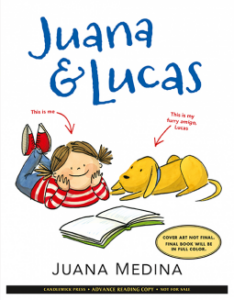 Juana and Lucas
Juana and Lucas
By Juana Medina
Candlewick Press
$14.99
ISBN: 978-1-7636-7208-9
Ages 6-9
On shelves now
Windows. Mirrors. Mirrors. Windows. Windowy mirrors. Mirrory windows. Windows. Mirrors. Sliding doors! Mirrors. Windows.
In the world of 21st century children’s literature, diversity should be the name of the game. We want books for our children that reflect the worlds they know and the worlds they have yet to greet. We want them to see themselves in their books (mirrors), see others unlike themselves (windows), and have a way to get from one place to another (sliding doors). To accomplish this, all you have to do is publish a whole bunch of books about kids of different races, religions, abilities, persuasions, you name it. Great strides have been made over the last few years in the general consciousness of the publishing industry (the publishers, the librarians, the teachers, and even the parents) even as teeny tiny, itty bitty, itsy bitsy tiptoes have been made in terms of what actually is getting published. Much of the credit for spearheading efforts to bring to light more and more books for all children can be given to the We Need Diverse Books movement. That said, our children’s rooms are still filled with monumental gaps. Contemporary Jewish characters are rare. Muslim characters rarer still. And don’t even TALK to me about the state of kids in wheelchairs these days. Interestingly enough, the area where diversity has increased the most is in early chapter books. Whether it’s Anna Hibiscus, Lola Levine, Alvin Ho, or any of the other new and interesting characters out there, there is comfort to be found in those books that transition children from easy readers to full-blown novels. Into this world comes Juana Medina and her semi-autobiographical series Juana & Lucas. Short chapters meet universal headaches (with details only available in Bogota, Colombia) ultimately combining to bring us a gal who will strike you as both remarkably familiar and bracingly original.
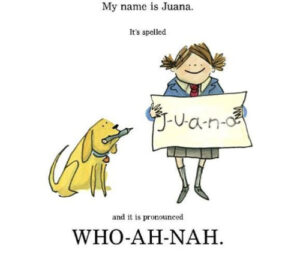 You might think that Juana has it pretty good, and for the most part you’d be right. She lives in Bogota, Colombia “the city that’s closest to my heart” with her Mami. She has a good furry best friend (her dog, Lucas) and a good not-so-furry best friend (Juli). And hey, it’s the first day of school! Cool, right? Only nothing goes the way Juana planned. The whole unfortunate day is capped off when one of her teachers informs the class that they will be learning “the English” this year. Could anything be more unfair? Yet as Juana searches for sympathy amongst her friends and relatives, she realizes that everyone seems to think that learning English is a good thing. Are they crazy? It isn’t until an opportunity comes up to visit somewhere fantastic, far away, and English speaking that she finally takes what everyone has told her to heart. In a big way.
You might think that Juana has it pretty good, and for the most part you’d be right. She lives in Bogota, Colombia “the city that’s closest to my heart” with her Mami. She has a good furry best friend (her dog, Lucas) and a good not-so-furry best friend (Juli). And hey, it’s the first day of school! Cool, right? Only nothing goes the way Juana planned. The whole unfortunate day is capped off when one of her teachers informs the class that they will be learning “the English” this year. Could anything be more unfair? Yet as Juana searches for sympathy amongst her friends and relatives, she realizes that everyone seems to think that learning English is a good thing. Are they crazy? It isn’t until an opportunity comes up to visit somewhere fantastic, far away, and English speaking that she finally takes what everyone has told her to heart. In a big way.
I love, first and foremost, the fact that the emotional crux of this book is fixated on Juana’s detestation of learning “the English”. Now already I’ve heard some commenters online complain that Juana’s problem isn’t something that English-speaking children will identify with. Bull. Any child that has ever learned to read will know where Juana is coming from. What English speaker would fail to sympathize when she asks, “Why are read and read written the same way but sound different? How can I know when people are talking about eyes or ice when they sound about the same? And what about left hand and left the room? So many words, so little sense”? Some kids reading this book may have experience learning another language too. For them, Juana’s complaints will ring true and clear. That’s a key aspect of her personality. She’s sympathetic, even when she’s whining.
For all that we’ve seen books like Juana’s, Lola Levine, Zapato Power, Pedro, First Grade Hero, Sophia Martinez, and a handful of others, interestingly this increase in Latino early chapter book is relatively recent. For a long time it was Zapato Power or nothing. The change is great, but it’s significant to note that all the books I’ve mentioned here are set in the United States. American books set in South American countries where the kids just live their daily lives and don’t have to deal with civil wars or invasions or coyotes or drug runners are difficult to find. What makes Juana and Lucas so unique is that it’s about a child living her life, having the kinds of problems that Ramona or Ruby Lu or Dyamonde Daniel could relate to. And like Anna Hibiscus or The Great Cake Mystery I love books for younger children that go through daily life in other present day countries. Windows indeed.
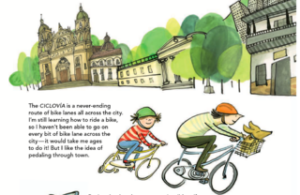 Early chapter books are interesting because publishers see them as far more series-driven than their writers might. An author can crank out title after title after title to feed the needs of their young readers, always assuming the demand is there, and they can do it easier with books under 100 pages than above. Juana could fit the bill in this regard. Her personality is likable, for starters. She’s not rude like Junie B. Jones or willfully headstrong in the same way as Ramona, but she does screw up. She does complain wildly. There are aspects of her personality you can identify with right from the start. I’d be pleased to see more of her in the future, and young readers will undoubtedly feel the same way. Plus, she has one particular feature that puts her heads and tails above a lot of the competition: She’s in color.
Early chapter books are interesting because publishers see them as far more series-driven than their writers might. An author can crank out title after title after title to feed the needs of their young readers, always assuming the demand is there, and they can do it easier with books under 100 pages than above. Juana could fit the bill in this regard. Her personality is likable, for starters. She’s not rude like Junie B. Jones or willfully headstrong in the same way as Ramona, but she does screw up. She does complain wildly. There are aspects of her personality you can identify with right from the start. I’d be pleased to see more of her in the future, and young readers will undoubtedly feel the same way. Plus, she has one particular feature that puts her heads and tails above a lot of the competition: She’s in color.
Created in ink and watercolor, Medina illustrates as well as writes her books. This art actually puts the book in a coveted place few titles can brag. You might ask if there’s a middle point between easy books and, say, Magic Tree House titles. I’d say this book was it. Containing a multitude of full-color pictures and spreads, it offers kids the comfort of picture books with the sensibility and sophistication of chapter book literature. And since she’s already got the art in place, why not work in some snazzy typography as well? Medina will often integrate individual words into the art. They swoop and soar around the characters, increasing and decreasing in size, according to their wont. Periodically a character will be pulled out and surrounded by fun little descriptor tidbits about their personage in a tiny font. Other times sentences move to imitate what their words say, like when Juana discusses how Escanilberto can kick the ball, “hard enough to send it across the field.” That sentence moves from his foot to a point just above his opponent’s head, the ball just out of reach. I like to think this radical wordplay plays into the early reader’s enjoyment of the book. It’s a lot more fun to read a chapter book when you have no idea what the words are going to pull on you next.
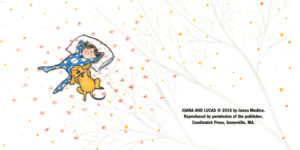 The writing is good, though the conclusion struck me as a bit rushed. Admittedly the solution to Juana’s problems is tied up pretty quickly. She won’t learn, she won’t learn, she won’t learn. She gets to have a prize? She studies and studies and studies. So rather than have her come to an understanding of English’s use on her own, an outside force (in this case, the promise of seeing Astroman) is the true impetus to her change. Sure, at the very end of the book she suddenly hits on the importance of learning other languages and visiting other places around the globe but it’s a bit after the fact. Not a big problem in the book, of course, but it would have been cool to have Juana come to this realization without outside influences.
The writing is good, though the conclusion struck me as a bit rushed. Admittedly the solution to Juana’s problems is tied up pretty quickly. She won’t learn, she won’t learn, she won’t learn. She gets to have a prize? She studies and studies and studies. So rather than have her come to an understanding of English’s use on her own, an outside force (in this case, the promise of seeing Astroman) is the true impetus to her change. Sure, at the very end of the book she suddenly hits on the importance of learning other languages and visiting other places around the globe but it’s a bit after the fact. Not a big problem in the book, of course, but it would have been cool to have Juana come to this realization without outside influences.
As nutty as it sounds, Juana and Lucas is a bit short on the “Lucas” side of that equation. Juana’s the true star of the show here, relegating man’s best friend to the sidelines. Fortunately, I have faith in this series. I have faith that it will return for future sequels and that when those sequels arrive they’ll have a storyline for Lucas to carry on his own. With Juana nearby, of course. After all, she belongs to the pantheon of strong female early chapter characters out there, ready to teach kids about life in contemporary Colombia even as she navigates her own trials and successes. And it’s funny. Did I mention it’s funny? You probably got that from context, but it bears saying. “Juana and Lucas” is the kind of book I’d like to see a lot more of. Let’s hope Ms. Medina is ready to spearhead a small revolution of early chapter book international diversity of her very own.
On shelves now.
Like This? Then Try:


By:
Betsy Bird,
on 10/11/2016
Blog:
A Fuse #8 Production
(
Login to Add to MyJacketFlap)
JacketFlap tags:
Reviews,
Best Books,
Anne Herbauts,
French children's books,
Enchanted Lion Books,
French picture books,
translated picture books,
international children's books,
Best Books of 2016,
2016 imports,
2016 picture books,
2016 reviews,
Reviews 2016,
2016 translated children's books,
Add a tag
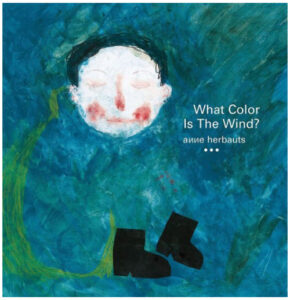 What Color Is the Wind?
What Color Is the Wind?
By Anne Herbauts
Translated by Claudia Zoe Bedrick
Enchanted Lion Books
$19.95
ISBN: 978-1-59270-221-3
Ages 5 and up
On shelves now
I’m going to have a hard time of it when my kids grow up. When I had them I swore up, down and sideways that I wouldn’t turn into the kind of blogger that declares that a book is good or bad, based solely on the whims of my impertinent offspring. For the most part, I’ve kept that promise. I review picture books outside of their influence, though I’m always interested in their opinions. Indeed, these opinions, and the sharp eyes that inform them, are sometimes not what I’d expect at all. So while I’ve never changed my opinion from liking a book to not liking it just because it didn’t suit my own particular kids’ tastes, I have admittedly found a new appreciation for other books when the children were able to spot things that I did not. What Color Is the Wind? is a pretty good example of this. I read the book at work, liked it fine, and brought it home for a possible review. My daughter then picked it up and proceeded to pretty much school me on what it contained, front to finish. Had I noticed the Braille on the cover? No. Did I see that the main character’s eyes are closed the whole time? No. How about the tactile pages? Did you notice that you can feel almost all of them? No. For a book that may look to some readers as too elegant and sophisticated to count as a favored bedtime story, think again. In this book Anne Herbauts proves beyond a shadow of a doubt that a distinct European style is engaging to American children when their parents give it half a chance. Particularly when tactile elements are involved.
 “We can’t see the wind, / we hear what it brings. / We can’t hear the wind, / we see what it brings.” The book begins with a question. A boy, his eyes closed, walks behind the cutout of a house. “What color is the wind? asks the little giant.” As he walks along, various plants, birds, animals, and inanimate objects offer answers. A wolf says the wind’s color is “the dark smell of the forest” while a window disagrees and says it’s “the color of time.” Everything that answers the little giant has a different feel on the page. The stream feels like consecutive ripples emanating from a dropped pebble, the roots of an apple tree like long, thin rivulets. At last the little giant encounters something that he senses is enormous. He asks his question and an enormous giant replies, “It is everything at once. This whole book.” He flips the book’s pages with his thumb so that they fly, and you the reader do the same, feeling the wind the book is capable of producing with its thick, lustrous pages. The color of the wind. The wind of this book.
“We can’t see the wind, / we hear what it brings. / We can’t hear the wind, / we see what it brings.” The book begins with a question. A boy, his eyes closed, walks behind the cutout of a house. “What color is the wind? asks the little giant.” As he walks along, various plants, birds, animals, and inanimate objects offer answers. A wolf says the wind’s color is “the dark smell of the forest” while a window disagrees and says it’s “the color of time.” Everything that answers the little giant has a different feel on the page. The stream feels like consecutive ripples emanating from a dropped pebble, the roots of an apple tree like long, thin rivulets. At last the little giant encounters something that he senses is enormous. He asks his question and an enormous giant replies, “It is everything at once. This whole book.” He flips the book’s pages with his thumb so that they fly, and you the reader do the same, feeling the wind the book is capable of producing with its thick, lustrous pages. The color of the wind. The wind of this book.
The Kirkus review journal said that this book was, “ ‘The blind men and the elephant’ reworked into a Zen koan” and then proceeded to recommend it for 9-11 year-olds and adults. I’m fairly certain I disagree with almost every part of that. Now here’s the funny part. I didn’t read this review before I read the book. I also didn’t read the press release that was sent to me with it. When I read a book I like to be surprised by it in some way. This is usually a good thing, but once in a while I can be a bit dense and miss the bigger picture. As I mentioned before, I completely missed the fact that this book was an answer to a blind child who had asked Anne Herbauts the titular question. I just thought it was cool that the book was so much fun to touch. Embossing, debossing, die-cuts, lamination, and all kinds of surfaces give the book the elements that make it really pop. As I read it in the lunchroom at work, my co-workers would peer over my shoulders to coo at what they saw. All well and good, but would a kid be interested too? Kirkus says they’d have to be at least nine to grasp its subtleties.
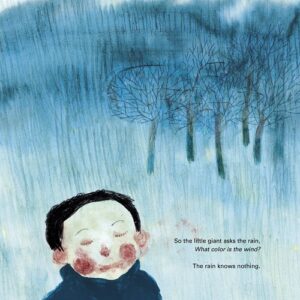 Obviously my 5-year-old daughter likes the book but she’s just one kid. She is not a representative for her species (so to speak). That said, this book just drills home the advantage that physical books have over their electronic counterparts: the sensation of touch. Play with a screen all day if you like, but you will never be able to move your fingers over these raised dots of rain or the rough bark of a tree’s trunk. As children become more immersed in the electronic, they become more enamored of tactile books. The sensation of paper on skin has yet to be replicated by our smooth as silk screens. And this will prove true with kids on the younger end of the scale. I’ll agree with Kirkus about the adult designation, though. When I worked for New York Public Library there was a group of special needs adults that would come in that were in need of tactile picture books. We would be asked if we had any on hand that we could hand over to them in some way. There were a few, but our holdings were pretty limited (though I do remember a particularly keen tactile version of The Very Hungry Caterpillar that proved to be a big hit). Those kids would have loved this book, but children of all ages, and all abilities, would feel the same way about it. Kids are never too old for tactile picture books. As such, you could use this book with Kindergartners as well as fifth graders. Little kids will like the fun pictures. Older kids may be inspired by the words as well.
Obviously my 5-year-old daughter likes the book but she’s just one kid. She is not a representative for her species (so to speak). That said, this book just drills home the advantage that physical books have over their electronic counterparts: the sensation of touch. Play with a screen all day if you like, but you will never be able to move your fingers over these raised dots of rain or the rough bark of a tree’s trunk. As children become more immersed in the electronic, they become more enamored of tactile books. The sensation of paper on skin has yet to be replicated by our smooth as silk screens. And this will prove true with kids on the younger end of the scale. I’ll agree with Kirkus about the adult designation, though. When I worked for New York Public Library there was a group of special needs adults that would come in that were in need of tactile picture books. We would be asked if we had any on hand that we could hand over to them in some way. There were a few, but our holdings were pretty limited (though I do remember a particularly keen tactile version of The Very Hungry Caterpillar that proved to be a big hit). Those kids would have loved this book, but children of all ages, and all abilities, would feel the same way about it. Kids are never too old for tactile picture books. As such, you could use this book with Kindergartners as well as fifth graders. Little kids will like the fun pictures. Older kids may be inspired by the words as well.
“Mom,” said my daughter as we went down the stairs for her post-reading, pre-brushing, nighttime snack. “Mom, you know the wind doesn’t have a color, right?” My child is a bit of a literalist. She’s the kid who knew early on that magic wasn’t real and once told me at the age of three that, “If ‘please’ is a magic word, it doesn’t exist.” So to read an entire book, based on the premise of seeing a color that couldn’t possibly be real, was a stretch for her. Remember, we read this entire book without really catching on that the little giant was blind. I countered that it was poetry, really. Colors were just as much about what they looked like as what they felt like. I asked her what blue made her feel, and red. Then I applied that to the emotions we feel about with the wind, which wasn’t really an analogy that held much water, but she was game to hear me out. “It’s poetry”, I said again. “Words that make you feel something when you read them.” So, as she had her snack, she had me read her some poetry. We’ve been reading poetry with her snack every night since. So for all that the book could be seen to be a straightforward picture book, to me it’s as much an introduction to poetry as anything else.
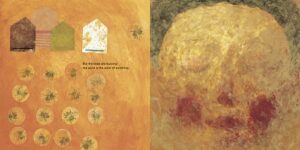
As for the art, I’ll admit that the combination of the style of art, the image on the cover, and the fact that the book is softcover and not hardcover (a cost-saving measure for what must be a very expensive title for Enchanted Lion Books to publish) did not immediately appeal to me. There’s no note to explain what the medium is and if I were to guess I’d say we were looking at crayons, mixed media, thick paints, colored pencils, ink blots, pen-and-inks, and more. Ironically, I really began to gravitate to the art when the little giant wasn’t stealing my focus. Nothing is intricately detailed, except perhaps the anatomy of honeybees or the raised and bumpy parts of the book. At the same time, for a book that celebrates touch, poetry, and physical sensation, the colors are often bright and lush. Whether it’s the blue watercolors of rain over trees or the hot orange that emanates from the page like a sun, Herbauts is simultaneously rendering illustrations obsolete with the unique format of What Color is the Wind? and celebrating their visual extremes.
I tend to give positive reviews to books that exceed my expectations. That’s just the nature of my occupation. And while I do believe that there are elements to this book that could be clearer or that there must have been a book jacket choice they could have chosen that was more appealing than the one you see here, otherwise I think this little book is a bit of a wonder. Deeply appealing to children of all ages, to say nothing of the adults out there, with so many uses, and so many applications. It reminds me of the old picture books by Bruno Munari that weren’t afraid to try new things with the picture book format. To get a little crazy. I don’t think we’ll suddenly see a big tactile picture book craze sweep the nation or anything, but maybe this book will inspire just one other publisher to try something a little different and to take a risk. Could be worth it. There’s nothing else like this book out there today. More’s the pity.
On shelves now.
Source: Final edition sent from publisher for review.
Like This? Then Try:
Professional Reviews:
Misc: A deeper look at some of the art over at Seven Impossible Things Before Breakfast

“If we don’t offer children literature from other languages, we are starving them.” Philip Pullman (TES, 2005)
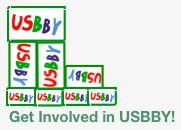 Phew! I’d been planning on doing a round-up of some of the speeches and talks I sat in on at the ALA Conference in Orlando a week or so ago, only to find that I’d lost my notes. They have since resurfaced.
Phew! I’d been planning on doing a round-up of some of the speeches and talks I sat in on at the ALA Conference in Orlando a week or so ago, only to find that I’d lost my notes. They have since resurfaced.
When one attends an ALA Conference in full, it is useful to decide early what kind of talks you’d like to attend. Is your interest in copyright or preservation? Do you have more of a yen to learn about sustainable thinking, coding groups, STEM collaboration, or small scale digitization? This year I decided to concentrate more on international children’s literature. It’s an interest that has grown within me over the past few years and I was curious to learn more about the topic.
First up, Diverse Books from Across the Globe. Description: “How can the local library help voices from emerging markets and developing countries be heard? How can we make their books available to refugee populations and foreign language speakers across the United States? Join innovators from Library for All to look at how libraries can continue to support access to quality educational materials in an increasingly global context.” The panelists included Rebecca McDonald of Library for All, Kerri Poore of First Book, and Hannah Ehrlich of Lee & Low Books.
This was right up my alley. As I say, my interest in international literature for kids has peaked over the last few years, possibly kickstarted by an event held at The New School in NYC that addressed American discomfort with books from other nations. With all the talk of getting kids to read more diverse books, there’s been very little talk about getting kids to read books that are from a diverse range of countries. Windows and mirrors are great, but why do the windows always have to look at our own back yards? Now with the rise of Donald Trump and the recent Brexit vote, nativism is at an all-time high, making me wonder why we don’t talk more about the value of teaching kids about other cultures through those nations’ books. I’m no innocent. I don’t think the world’s problems can be solved if kids in Texas read more books written for kids in Iraq. Nor do I think that American discomfort with the art of other nations (whether it’s foreign films or translated novels) is relegated solely to picture books. That said, there is value in learning, at a young age, the different ways in which other nations and cultures tell their stories.
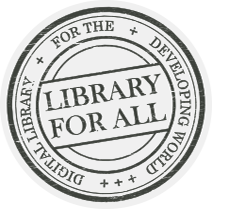 So! The talk! It was such an interesting collection of speakers. The focus of this particular panel was how to meet the needs of kids in the United States that have families from international cultures. I confess that I’d never heard of Library for All before. Though their primary purpose is to bring books to poverty stricken areas of the world, the organization also works closely with First Book to bring books from other countries to kids here in America. What struck me as particularly interesting is how they will essentially become book detectives for specific cultures and languages. Which is to say, they’ll go into other countries to seek out and find books that would otherwise never make it to American shores.
So! The talk! It was such an interesting collection of speakers. The focus of this particular panel was how to meet the needs of kids in the United States that have families from international cultures. I confess that I’d never heard of Library for All before. Though their primary purpose is to bring books to poverty stricken areas of the world, the organization also works closely with First Book to bring books from other countries to kids here in America. What struck me as particularly interesting is how they will essentially become book detectives for specific cultures and languages. Which is to say, they’ll go into other countries to seek out and find books that would otherwise never make it to American shores.
When it was time for questions I asked how librarians can work to promote international books here in the United States. There are some problems with doing so, of course. There is, and has always been, a marked preference for diverse American books vs. diverse international literature. Add in the fact that such books can only win a couple awards here and there, and there’s very little incentive on the part of the publishers to promote or distribute them.
In answering it was Hannah Ehrlich who gave me quite a lot to chew on. She pointed out to me (and this is key) that this isn’t just a children’s book problem. The wider difficulty comes with getting Americans as a whole used to different narrative styles. One way to do this is to get very young children used to these different kinds of books from the start.
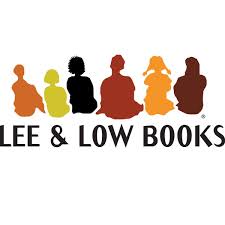 Another factor? The discoverability of international children’s book is key. Visibility is, in many ways, the greatest hurdle to overcome. That’s why we have USBBY lists like their yearly release of Outstanding International Books (you can find the 2016 list here). But the greatest hurdle? Getting such books into curriculum. To do this, publishers like Lee & Low work with the school and library market. The problem is that the text complexity of these books is often their downfall. Books written for foreign markets don’t care two bits about leveling. As a result, they’re often kept out of those schools that live and die by Fountas and Pinnell and their ilk.
Another factor? The discoverability of international children’s book is key. Visibility is, in many ways, the greatest hurdle to overcome. That’s why we have USBBY lists like their yearly release of Outstanding International Books (you can find the 2016 list here). But the greatest hurdle? Getting such books into curriculum. To do this, publishers like Lee & Low work with the school and library market. The problem is that the text complexity of these books is often their downfall. Books written for foreign markets don’t care two bits about leveling. As a result, they’re often kept out of those schools that live and die by Fountas and Pinnell and their ilk.
So what can be done? The panelists had some excellent suggestions. First off, let’s be honest. International children’s literature can sometimes be a hard sell. You can’t introduce these books to Americans cold. If you’re going to introduce a global perspective into your classroom, you need to foster a dialogue around these books. As for librarians, do displays of translated children’s books! Start international book clubs where you highlight a different country every month. And be aware that some types of books simply do not exist in other countries. Young adult literature, for example, just isn’t an age level designation in some places.
It was a good talk.
The second one I attended a little later was entitled Conversation Starter: Other People’s Voices: Using Global Literature in Translation to Reimagine Diversity in Libraries. Its panel consisted of Rachel Hildebrandt, Marc Aronson, and moderator Doris Gebel.
The problem? I had difficulty finding the room and missed Marc Aronson’s opening remarks. Too bad, since the man is a positive machine of good quotes. Here’s one I was able to catch:
“It is wrong to hem our children in to a national experience when they are living an international experience.”
Since the focus on this talk was, to a certain extent, translation, I was particularly intrigued by a mention made of something called The Global Literature in Libraries Initiative. In June there was an excellent piece in YALSA’s The Hub blog explaining what this is. As their mission statement says:
“. . . the Global Literature in Libraries Initiative strives to raise the visibility of world literature for adults and children at the local, national and international levels. We intend to do so by facilitating close and direct collaboration between translators and librarians, because we believe translators are uniquely positioned to help librarians provide support and events to engage readers of all ages in a library framework that explores and celebrates literature from around the world.”
There are a lot of great points in the piece. For example, when talking about the lack of international books available to a lot of kids today in our increasingly interconnected global world it said that, “Librarians play a key role in counteracting this dangerous insularity.”
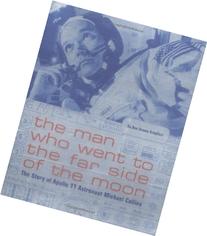 On the panel, the panelists mentioned that our love affair with translation is a funny, fickle thing. We do well when it comes to Pippi Longstocking, but we’re not great when it comes to contemporary literature. That gives the U.S. book market, and American children’s books in general, cultural dominance. To get an outsider perspective is invaluable to kids today. For example, in 2004 Chronicle Books won the Batchelder Award for The Man Who Went to the Far Side of the Moon: The Story of Apollo 11 Astronaut Michael Collins by Bea Uusma Schyffert, translated from the Swedish by Emi Guner. And let me tell you, our space program looks a LOT different when its story is told by someone other than rah-rah Americans.
On the panel, the panelists mentioned that our love affair with translation is a funny, fickle thing. We do well when it comes to Pippi Longstocking, but we’re not great when it comes to contemporary literature. That gives the U.S. book market, and American children’s books in general, cultural dominance. To get an outsider perspective is invaluable to kids today. For example, in 2004 Chronicle Books won the Batchelder Award for The Man Who Went to the Far Side of the Moon: The Story of Apollo 11 Astronaut Michael Collins by Bea Uusma Schyffert, translated from the Swedish by Emi Guner. And let me tell you, our space program looks a LOT different when its story is told by someone other than rah-rah Americans.
Doris Gebel urged the attendees to start kids young on international literature. Fail to do so and they won’t have a yearning for it as teens. Show them those “strange” books that confuse you, the adult. “Our young children need other books from other lands every day.”
Mention was made of the two major book lists/awards of translated children’s literature in the States. One is the Batchelder Award (named after Evanston librarian Mildred L. Batchelder so HOMETOWN PRIDE!) which is given each year. The International Books List (which I mentioned before) celebrates 40 books and breaks them down by age groups. That’s great, but the bulk of the books are from Western countries.
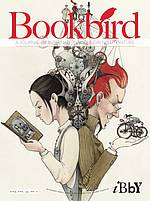 It was at this point that Marc Aronson spoke about the importance of distinctive translations. Take Anne Frank’s diary, for example. The version we read in schools is a very particular rendering. A lot of people would be shocked to hear that there are different versions out there. This reminded me of an article I read in Book Bird (a fantastic international children’s book periodical) years ago about how translating Hans Christian Andersen changes the meaning of his stories, depending on the translator. Until I read that piece it wasn’t something I’d thought about. As Marc said, “Translation is a creative act.” Mention was made at this time of the fact that for the very first time a woman has translated an edition of Madame Bovary. Meanwhile the famous translator of 100 Years of Solitude just died. If you think you know that book and you speak English, you only know his version.
It was at this point that Marc Aronson spoke about the importance of distinctive translations. Take Anne Frank’s diary, for example. The version we read in schools is a very particular rendering. A lot of people would be shocked to hear that there are different versions out there. This reminded me of an article I read in Book Bird (a fantastic international children’s book periodical) years ago about how translating Hans Christian Andersen changes the meaning of his stories, depending on the translator. Until I read that piece it wasn’t something I’d thought about. As Marc said, “Translation is a creative act.” Mention was made at this time of the fact that for the very first time a woman has translated an edition of Madame Bovary. Meanwhile the famous translator of 100 Years of Solitude just died. If you think you know that book and you speak English, you only know his version.
Today, things are perking up. In the last five years we’ve seen more small independent presses translating children’s books than ever before. Often these publishers are their own translators. Look at that USBBY list. It’s almost entirely small presses. And if these small presses don’t get reviewed in most of the journals out there (Kirkus is beloved to me because they take special care in reviewing the little guys) then the books just don’t get any attention.
When the audience members came up to speak, we heard some fascinating takes on all this. One woman said that the bulk of books translated from Colombia in the United States are about losing weight. She has Colombian immigrants in her library wondering aloud to her why Americans want them to lose weight so much, but that’s just what’s (weirdly) available.
So let’s talk solutions. What can libraries do to promote translated materials? Well, we could work with our immigrant communities more. Doris also pointed out that storytimes of translated books and library displays of translations could be useful as well. That got me to thinking how cool it would be if someone were to create lists like, “Top Ten Kids’ Books Translated from German” or “Top Ten Kids’ Books Translated from Swahili”. Or by country!
 Which finally brings us to the International Digital Children’s Library. If you haven’t seen it yet, please check it out. Seeking to serve the international community, the site makes, “the best in children’s literature available online free of charge.”
Which finally brings us to the International Digital Children’s Library. If you haven’t seen it yet, please check it out. Seeking to serve the international community, the site makes, “the best in children’s literature available online free of charge.”
Also mentioned was the collection at Worlds of Words, at the University of Arizona. The description reads, “Worlds of Words is committed to providing a range of resources to encourage educators at all levels to integrate global literature into the lives of children. The resources on this site grew out of work in schools around the world and the identification of needs…”
Thanks to both panels for this fascinating exchange of ideas. Much to chew on here.


By:
Betsy Bird,
on 2/14/2016
Blog:
A Fuse #8 Production
(
Login to Add to MyJacketFlap)
JacketFlap tags:
issue picture books,
Julie Pearson,
Pajama Press,
translated picture books,
Reviews,
Canadian children's books,
Canadian picture books,
Manon Gauthier,
international children's books,
diverse picture books,
2016 picture books,
Reviews 2016,
Add a tag
 Elliot
Elliot
By Julie Pearson
Translated by Erin Woods
Illustrated by Manon Gauthier
Pajama Press
$16.95
ISBN: 978-1-927485-85-9
Ages 4-7
On shelves April 4th
The librarian and the bookseller face shelving challenges the like of which you wouldn’t believe. You think all picture books should simply be shelved in the picture book section by the author’s last name and that’s the end of it? Think again. If picture books served a single, solitary purpose that might well be the case. But picture books carry heavy burdens, far above and beyond their usual literacy needs. People use picture books for all sorts of reasons. There are picture books for high school graduates, for people to read aloud during wedding ceremonies, for funerals, and as wry adult jokes. On the children’s side, picture books can help parents and children navigate difficult subjects and topics. From potty training to racism, complicated historical moments and new ways of seeing the world, the picture book has proved to be an infinitely flexible object. The one purpose that is too little discussed but is its most complicated and complex use is when it needs to explain the inexplicable. Cancer. Absentee parents. Down syndrome. Explaining just one of these issues at a time is hard. Explaining two at one time? I’d say it was almost impossible. Julie Pearson’s book Elliot takes on that burden, attempting to explain both the foster system and children with emotional developmental difficulties at the same time. It works in some ways, and it doesn’t work in others, but when it comes to the attempt itself it is, quite possibly, heroic.
Elliot has a loving mother and father, that much we know. However, for whatever reason, Elliot’s parents have difficulty with their young son. When he cries, or yells, or misbehaves they have no idea how to handle these situations. So the social worker Thomas is called in and right away he sets up Elliot in a foster home. There, people understand Elliot’s needs. He goes home with his parents, after they learn how to take care of him, but fairly soon the trouble starts up again. This time Thomas takes Elliot to a new foster care home, and again he’s well tended. So much so that even though he loves his parents, he worries about going home with them. However, in time Thomas assures Elliot that his parents will never take care of him again. And then Thomas finds Elliot a ‘forever” home full of people who love AND understand how to take care of him. One he never has to leave.
 Let me say right here and now that this is the first picture book about the foster care system, in any form, that I have encountered. Middle grade fiction will occasionally touch on the issue, though rarely in any depth. Yet in spite of the fact that thousands and thousands of children go through the foster care system, books for them are nonexistent. Even “Elliot” is specific to only one kind of foster care situation (children with developmental issues). For children with parents who are out of the picture for other reasons, they may take some comfort in this book, but it’s pretty specific to its own situation. Pearson writes from a place of experience, and she’s writing for a very young audience, hence the comforting format of repetition (whether we’re seeing Elliot’s same problems over and over again, or the situation of entering one foster care home after another). Pearson tries to go for the Rule of Three, having Elliot stay with three different foster care families (the third being the family he ends up with). From a literary standpoint I understand why this was done, and I can see how it reflects an authentic experience, but it does seem strange to young readers. Because the families are never named, their only distinguishing characteristics appear to be the number of children in the families and the family pets. Otherwise they blur.
Let me say right here and now that this is the first picture book about the foster care system, in any form, that I have encountered. Middle grade fiction will occasionally touch on the issue, though rarely in any depth. Yet in spite of the fact that thousands and thousands of children go through the foster care system, books for them are nonexistent. Even “Elliot” is specific to only one kind of foster care situation (children with developmental issues). For children with parents who are out of the picture for other reasons, they may take some comfort in this book, but it’s pretty specific to its own situation. Pearson writes from a place of experience, and she’s writing for a very young audience, hence the comforting format of repetition (whether we’re seeing Elliot’s same problems over and over again, or the situation of entering one foster care home after another). Pearson tries to go for the Rule of Three, having Elliot stay with three different foster care families (the third being the family he ends up with). From a literary standpoint I understand why this was done, and I can see how it reflects an authentic experience, but it does seem strange to young readers. Because the families are never named, their only distinguishing characteristics appear to be the number of children in the families and the family pets. Otherwise they blur.
Pearson is attempting to make this accessible for young readers, so that means downplaying some of the story’s harsher aspects. We know that Elliot’s parents are incapable of learning how to take care of him. We are also assured that they love him, but we never know why they can’t shoulder their responsibilities. This makes the book appropriate for young readers, but to withdraw all blame on the parental side will add a layer of fear for those kids who encounter this book without some systematic prepping beforehand. It would be pretty easy for them to say, “Wait. I sometimes cry. I sometimes misbehave. Are my parents going to leave me with a strange family?”
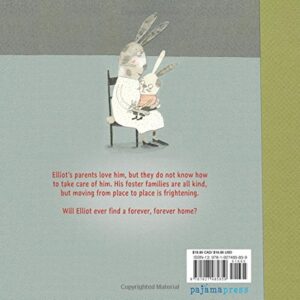 Artist Manon Gauthier is the illustrator behind this book and here she employs a very young, accessible style. Bunnies are, for whatever reason, the perfect animal stand-in for human problems and relationships, and so this serious subject matter is made younger on sight. With this in mind, the illustrator’s style brings with it at least one problematic issue. I suspect that many people that come to this book will approach it in much the same way that I did. My method of reading picture books is to grab a big bunch of them and carry them to my lunch table. Then I go through them and try to figure out which ones are delightful, which ones are terrible, and which ones are merely meh (that would be the bulk). I picked up Elliot and had the reaction to it that I’m sure a lot of people will. “Aw. What a cute little bunny book” thought I. It was around the time Elliot was taken from his family for the second time that I began to catch on to what I was reading. A fellow children’s librarian read the book and speculated that it was the choice of artist that was the problem. With its adorable bunny on the cover there is little indication of the very serious content inside. I’ve pondered this at length and in the end I’ve decided that it’s not the style of the art that’s problematic here but the choice of which image to show on the book jacket. Considering the subject matter, the publisher might have done better to go the The Day Leo Said, ‘I Hate You’ route. Which is to say, show a cover where there is a problem. On the back of the book is a picture of Elliot looking interested but wary on the lap of a motherly rabbit. Even that might have been sufficiently interesting to make readers take a close read of the plot description on the bookflap. It certainly couldn’t have hurt.
Artist Manon Gauthier is the illustrator behind this book and here she employs a very young, accessible style. Bunnies are, for whatever reason, the perfect animal stand-in for human problems and relationships, and so this serious subject matter is made younger on sight. With this in mind, the illustrator’s style brings with it at least one problematic issue. I suspect that many people that come to this book will approach it in much the same way that I did. My method of reading picture books is to grab a big bunch of them and carry them to my lunch table. Then I go through them and try to figure out which ones are delightful, which ones are terrible, and which ones are merely meh (that would be the bulk). I picked up Elliot and had the reaction to it that I’m sure a lot of people will. “Aw. What a cute little bunny book” thought I. It was around the time Elliot was taken from his family for the second time that I began to catch on to what I was reading. A fellow children’s librarian read the book and speculated that it was the choice of artist that was the problem. With its adorable bunny on the cover there is little indication of the very serious content inside. I’ve pondered this at length and in the end I’ve decided that it’s not the style of the art that’s problematic here but the choice of which image to show on the book jacket. Considering the subject matter, the publisher might have done better to go the The Day Leo Said, ‘I Hate You’ route. Which is to say, show a cover where there is a problem. On the back of the book is a picture of Elliot looking interested but wary on the lap of a motherly rabbit. Even that might have been sufficiently interesting to make readers take a close read of the plot description on the bookflap. It certainly couldn’t have hurt.
Could this book irreparably harm a child if they encountered it unawares? Short Answer: No. Long Answer: Not even slightly. But could they be disturbed by it? Sure could. I don’t think it would take much stretch of the imagination to figure that the child that encounters this book unawares without any context could be potentially frightened by what the book is implying. I’ll confess something to you, though. As I put this book out for review, my 4-year-old daughter spotted it. And, since it’s a picture book, she asked if I could read it to her. I had a moment then of hesitation. How do I give this book enough context before a read? But at last I decided to explain beforehand as much as I could about children with developmental disabilities and the foster care system. In some ways this talk boiled down to me explaining to her that some parents are unfit parents, a concept that until this time had been mercifully unfamiliar to her. After we read the book, her only real question was why Elliot had to go through so many foster care families, so we got to talk about that for a while It was a pretty valuable conversation and not one I would have had with her without the prompting of the book itself. So outside of children that have an immediate need of this title, there is a value to the contents.
What’s that old Ranganathan rule? Ah, yes. “Every book its reader.” Trouble is, sometimes the readers exist but the books don’t. Books like Elliot are exceedingly rare sometimes. I’d be the first to admit that Pearson and Gauthier’s book may bite off a bit more than it can chew, but it’s hardly a book built on the shaky foundation of mere good intentions. Elliot confronts issues few other titles would dare, and if it looks like one thing and ends up being another, that’s okay. There will certainly be parents that find themselves unexpectedly reading this to their kids at night only to discover partway through that this doesn’t follow the usual format or rules. It’s funny, strange, and sad but ultimately hopeful at its core. Social workers, teachers, and parents will find it one way or another, you may rest assured. For many libraries it will end up in the “Parenting” section. Not for everybody (what book is?) but a godsend to a certain few.
On shelves April 4th.
Source: Galley sent from publicist for review.

Morning, folks. Here in the frozen tundra they call the Chicago area (a hot toddy to anyone who can explain to me why the wind blows TO the lake and not from it) we’re huddled in our homes dreaming of spring. So while you shiver and shake (obviously this does not apply to you tropical climate denizens) warm yourself over some truly goofy links today.
- Many things changed when I moved from NYC to Evanston. My commute is shorter. The air is clearer. And I’ve actually joined two (count ’em) two online mom groups. I had sort of heard of them before, but the idea of joining one for NYC moms was too daunting. With that in mind, this 10 Little Monkeys parody called to me. It speaks truth. Thanks to brother-in-law Steve for the link.
 So, uh, what’d you do this week? Did you start a campaign to collect #1000blackgirlbooks? A woman by the name of Marley Dias did that. Marley is also 11. Marley is clearly going to rule the world someday and I welcome that day when it comes. In the meantime, those authors and illustrators amongst you that have something to contribute, you might want to learn more. The address on where to send the books appears at the end of the article. Thanks to mom for the link.
So, uh, what’d you do this week? Did you start a campaign to collect #1000blackgirlbooks? A woman by the name of Marley Dias did that. Marley is also 11. Marley is clearly going to rule the world someday and I welcome that day when it comes. In the meantime, those authors and illustrators amongst you that have something to contribute, you might want to learn more. The address on where to send the books appears at the end of the article. Thanks to mom for the link.
- There are many places to go if you’re in the mood to see what precisely people are talking about when they discuss A Birthday Cake for George Washington. I’ve very much enjoyed the comments on Read Roger’s recent post A Bumpy Ride. Also enjoyable is Mitali Perkins’ blog where she considers what a different biography of Hercules might consist of. Food for thought.
- Look what Bob Staake’s next book looks like!! Look familiar?
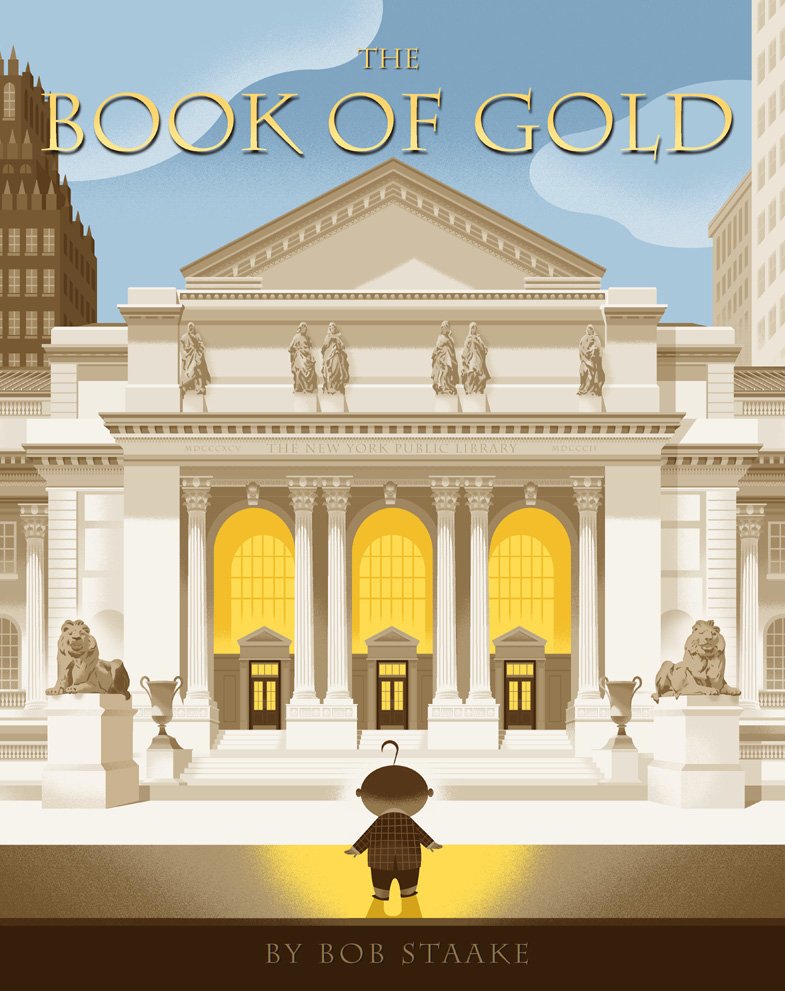
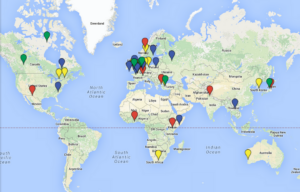 Every year USBBY (the United States Board on Books for Young People) creates a list of Outstanding International Books. They recently released their 2016 Outstanding International Books and it’s well worth a gander. If you feel that your knowledge of international children’s literature is lacking, boy are you in luck! The list is also available in bookmark form and as a Google Map form with annotations and cover art. Looking at it, you get a real sense of which countries are producing the most interesting children’s book imports. Wouldn’t mind an uptick in the number of African nations and South America is fairing poorly. I remember from my time visiting the Bologna Book Fair about 5 years ago the lack of South American books. If I recall, they mostly import and translate titles.
Every year USBBY (the United States Board on Books for Young People) creates a list of Outstanding International Books. They recently released their 2016 Outstanding International Books and it’s well worth a gander. If you feel that your knowledge of international children’s literature is lacking, boy are you in luck! The list is also available in bookmark form and as a Google Map form with annotations and cover art. Looking at it, you get a real sense of which countries are producing the most interesting children’s book imports. Wouldn’t mind an uptick in the number of African nations and South America is fairing poorly. I remember from my time visiting the Bologna Book Fair about 5 years ago the lack of South American books. If I recall, they mostly import and translate titles.
- They’re turning a YA novel into an opera. Cool, right? Let’s just go and see which one it’s gonna beeeeYAAAAAAAAHHHHH!!!! THAT one? They’re turning THAT novel into an opera? The novel that takes huge bites out of my soul every evening since I read it? THAT one?
Cool.
Daily Image:
This is for you teachers and parents out there. The V&A Museum has come up with this amazing design-your-own-wig feature on their website. Informative and fun and kind of disgusting all at once. What’s not to love? Consider this my ode to Seuss.
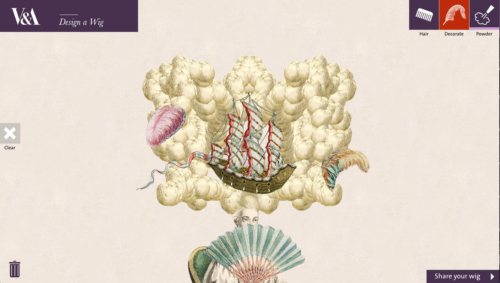
Many thanks to Alison Goodman for the link.


By:
[email protected],
on 10/12/2015
Blog:
Perpetually Adolescent
(
Login to Add to MyJacketFlap)
JacketFlap tags:
margaret mahy,
lloyd jones,
Gecko Press,
Wake,
joy cowley,
janet frame,
eleanor catton,
Elizabeth Pulford,
international children's books,
Elizabeth Knox,
Book Reviews - Childrens and Young Adult,
Book Reviews - Fiction,
NZ literature,
Joy Lawn,
Kate di Goldi,
Add a tag
There is an incredible depth of literary talent in New Zealand ranging from Booker Prize winner Eleanor Catton to Kate di Goldi, Lloyd Jones, Janet Frame and the incomparable Margaret Mahy. NZ is also the base for amazing publisher Gecko Press, which publishes books from around the world for children. We should keep an eye […]

By:
Betsy Bird,
on 5/4/2015
Blog:
A Fuse #8 Production
(
Login to Add to MyJacketFlap)
JacketFlap tags:
writing retreats,
Edgar Awards,
Kate Milford,
Fusenews,
Etienne Delessert,
Writing Barn,
international children's books,
Mathical Book Award,
book plates (haha),
forgotten children's books,
Funny Girl,
Harry Potter,
animation,
Native Americans,
Shannon Hale,
A Wrinkle in Time,
Oscar Wilde,
Add a tag
 “If kids like a picture book, they’re going to read it at least 50 times, and their parents are going to have to read it with them. Read anything that often, and even minor imperfections start to feel like gravel in the bed.” – Mark Haddon
“If kids like a picture book, they’re going to read it at least 50 times, and their parents are going to have to read it with them. Read anything that often, and even minor imperfections start to feel like gravel in the bed.” – Mark Haddon
I’ve just returned from speaking at a magnificent writing retreat weekend at Bethany Hegedus’s Writing Barn in Austin, Texas. That quote was one that Bethany read before Alexandra Penfold’s presentation and I like it quite a lot. Someone should start a picture book blog called “Gravel In the Bed”. If you need a good treat, I do recommend The Writing Barn wholeheartedly. The deer alone are worth the price of admission. And if you’ve other children’s book writing retreats you like, let me know what they are. I’m trying to pull together a list.
- I just want to give a shout out to my girl Kate Milford. I don’t always agree with the ultimate winners of The Edgar Award (given for the best mysteries) in the young person’s category but this year they knocked it out of the park. Greenglass House for the win!
- As you know, I’m working on the funny girl anthology FUNNY GIRL and one of my contributors is the illustrious Shannon Hale. She’s my personal hero most of the time and the recent post Boos for girls just nails down why that is. Thanks to bookshelves of doom for the link.
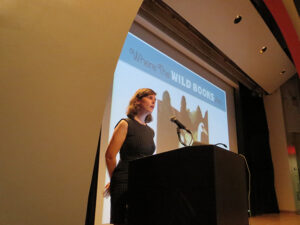 Not too long ago I was part of a rather large gathering based on one of my blog posts. The artist Etienne Delessert saw a piece I’d written on international picture books and how they’re perceived here in the States. So what did he do? He grabbed local consulates, flew in scholars, invited friends (like David Macaulay) and created an amazing free day that was hugely edifying and wonderful. You can read the SLJ report We need more international picture books, kid lit experts say or the PW piece Where the Wild Books Are: A Day of Celebrating Foreign Picture Books or the Monica Edinger recap International Children’s Books Considered. Very interesting look at these three different perspectives. And, naturally, I must thank Etienne for taking my little post so very far. This is, in a very real way, every literary blogger’s dream come true. Merci, Etienne!
Not too long ago I was part of a rather large gathering based on one of my blog posts. The artist Etienne Delessert saw a piece I’d written on international picture books and how they’re perceived here in the States. So what did he do? He grabbed local consulates, flew in scholars, invited friends (like David Macaulay) and created an amazing free day that was hugely edifying and wonderful. You can read the SLJ report We need more international picture books, kid lit experts say or the PW piece Where the Wild Books Are: A Day of Celebrating Foreign Picture Books or the Monica Edinger recap International Children’s Books Considered. Very interesting look at these three different perspectives. And, naturally, I must thank Etienne for taking my little post so very far. This is, in a very real way, every literary blogger’s dream come true. Merci, Etienne!
- There’s a lot of joy that can come when when a British expert discusses their nation’s “forgotten children’s classics“. The delightful Oxford Companion to Children’s Literature is out and its editor Daniel Hahn has recapped the books that he feels don’t get sufficient attention in Britain. Very funny to see one of our American classics on this list (I won’t ruin which one for you).
- How do we instill a sense of empathy in our kids? Have ‘em read Harry Potter. Apparently there’s now research to back that statement up. NPR has the story.
- Ooo. Wish I lived in L.A. for this upcoming talk. At UCLA there’s going to be a discussion of Oscar Wilde and the Culture of Childhood that looks at his fairytales. It ain’t a lot of money. See what they have to say.
- Because of I have ample time on my hands (hee hee hee hee . . . whooo) I also wrote an article for Horn Book Magazine recently. If you’ve ever wondered why we’re seeing so many refugees from the animation industry creating picture books, this may provide some of the answers.
- Over at the blog Views From the Tesseract, Stephanie Whelan has located a picture book so magnificent that it should be reprinted now now now. Imagine, if you will, a science fiction picture book starring an African-American girl . . . illustrated by Leo and Diane Dillon. Do you remember Blast Off?
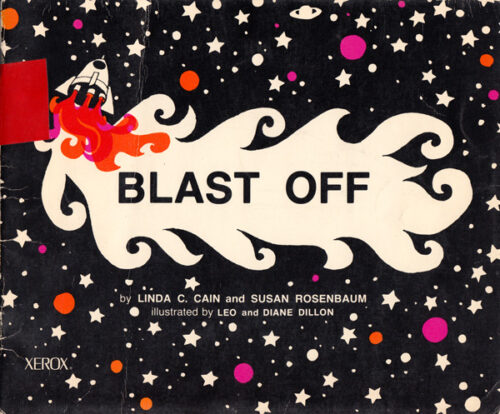
Of course you don’t. No one does. Stephanie has the interiors on her site. And since the number of books that show African-American girls as astronauts are . . . um . . . okay, I’ve never seen one. Plus it’s gorgeous and fun. REPRINT REPRINT REPRINT!
- Speaking of girls in space, I’ve never so regretted that a section was cut from a classic book. But this missing section from A Wrinkle in Time practically makes me weep for its lack. I WISH it had been included. It’s so very horribly horribly timely.
- As you’ll recall, the new math award for children’s books was established. So how do you submit your own? Well, new submissions for 2015 (and looking back an additional five years) will begin to be received starting June 1st. So FYI, kiddos.
Know a librarian getting married? Or an editor? Or an author? Gently suggest to them these for their registry.

Thanks to Stephanie Whelan for the link.


By:
Betsy Bird,
on 7/4/2012
Blog:
A Fuse #8 Production
(
Login to Add to MyJacketFlap)
JacketFlap tags:
Crockett Johnson,
Fusenews,
Philip Nel,
book apps,
international children's books,
Kazakhstan,
Uncategorized,
t-shirts,
Ruth Krauss,
Syd Hoff,
apps,
Add a tag
 Okay! So I’m a little out of practice when it comes to these news items and looking at some of the stuff I’ve accumulated in the last month, a good swath of it is out of date. Here’s what I have that’s current then.
Okay! So I’m a little out of practice when it comes to these news items and looking at some of the stuff I’ve accumulated in the last month, a good swath of it is out of date. Here’s what I have that’s current then.
Not long ago the good people at the Women’s National Book Association called me up and wondered if I’d be willing to participate in a kind of panel discussion with some female children’s author/illustrators . . . from Kazakhstan. Twist! Naturally I said yes indeed. I mean, how often do you come across that kind of an offer? Publishing Perspectives wrote up the meeting here. No pictures of me except a nice glimpse of my left arm. Publishers Weekly also wrote it up here but my favorite recounting is from what must be a translated site at How to Be Published which refers to me as a “New York Public Library girl materials dilettante”. If I were a tattoo kind of gal, I would make that my standard.
- Two news items regarding good leftist cartoonists/children’s authors of the past. The first is this fine cartoon tribute to Syd Hoff in Tablet by Sarah Lazarovic. Thanks to Marjorie Ingall for that link. The second regards one Mr. Crockett Johnson. As you might recall he will be featured in a dual biography with Ruth Krauss by the multi-talented Phil Nel this coming fall. The magnificent title is Crockett Johnson and Ruth Krauss: How an Unlikely Couple Found Love, Dodged the FBI, and Transformed Children’s Literature. And then there’s the drop dead gorgeous book jacket by Chris Ware. Phil pointed out that not only is Ware drawing in the style of Crockett, he’s also doing a Sendak here, a Mary Blair there, etc. It’s also one of the sexier Ruth Krauss images I’ve seen. Cannot wait to get my grubby mitts on that one.

- Not a New Blog Alert BUT . . . it might as well be for all that I’ve paid attention to it. When I write a review on this site I puff myself a little and feel smart because I’m capable of linking to other reviews. Big whoop. When the good folks at The Classroom Bookshelf review a book they don’t just review it. They interview the author via video, provide countless useful links, and generally make the book as useful and accessible to teachers as humanly possible. It just puts me to shame. They’re off for the summer (teachers, y’know) but that doesn’t mean you can’t get a bit of jaw-dropping in by seeing what they accomplished so far. Dear Lord, I stand amazed.
- Some more me stuff. First a
 Juana and Lucas
Juana and Lucas You might think that Juana has it pretty good, and for the most part you’d be right. She lives in Bogota, Colombia “the city that’s closest to my heart” with her Mami. She has a good furry best friend (her dog, Lucas) and a good not-so-furry best friend (Juli). And hey, it’s the first day of school! Cool, right? Only nothing goes the way Juana planned. The whole unfortunate day is capped off when one of her teachers informs the class that they will be learning “the English” this year. Could anything be more unfair? Yet as Juana searches for sympathy amongst her friends and relatives, she realizes that everyone seems to think that learning English is a good thing. Are they crazy? It isn’t until an opportunity comes up to visit somewhere fantastic, far away, and English speaking that she finally takes what everyone has told her to heart. In a big way.
You might think that Juana has it pretty good, and for the most part you’d be right. She lives in Bogota, Colombia “the city that’s closest to my heart” with her Mami. She has a good furry best friend (her dog, Lucas) and a good not-so-furry best friend (Juli). And hey, it’s the first day of school! Cool, right? Only nothing goes the way Juana planned. The whole unfortunate day is capped off when one of her teachers informs the class that they will be learning “the English” this year. Could anything be more unfair? Yet as Juana searches for sympathy amongst her friends and relatives, she realizes that everyone seems to think that learning English is a good thing. Are they crazy? It isn’t until an opportunity comes up to visit somewhere fantastic, far away, and English speaking that she finally takes what everyone has told her to heart. In a big way. Early chapter books are interesting because publishers see them as far more series-driven than their writers might. An author can crank out title after title after title to feed the needs of their young readers, always assuming the demand is there, and they can do it easier with books under 100 pages than above. Juana could fit the bill in this regard. Her personality is likable, for starters. She’s not rude like Junie B. Jones or willfully headstrong in the same way as Ramona, but she does screw up. She does complain wildly. There are aspects of her personality you can identify with right from the start. I’d be pleased to see more of her in the future, and young readers will undoubtedly feel the same way. Plus, she has one particular feature that puts her heads and tails above a lot of the competition: She’s in color.
Early chapter books are interesting because publishers see them as far more series-driven than their writers might. An author can crank out title after title after title to feed the needs of their young readers, always assuming the demand is there, and they can do it easier with books under 100 pages than above. Juana could fit the bill in this regard. Her personality is likable, for starters. She’s not rude like Junie B. Jones or willfully headstrong in the same way as Ramona, but she does screw up. She does complain wildly. There are aspects of her personality you can identify with right from the start. I’d be pleased to see more of her in the future, and young readers will undoubtedly feel the same way. Plus, she has one particular feature that puts her heads and tails above a lot of the competition: She’s in color. The writing is good, though the conclusion struck me as a bit rushed. Admittedly the solution to Juana’s problems is tied up pretty quickly. She won’t learn, she won’t learn, she won’t learn. She gets to have a prize? She studies and studies and studies. So rather than have her come to an understanding of English’s use on her own, an outside force (in this case, the promise of seeing Astroman) is the true impetus to her change. Sure, at the very end of the book she suddenly hits on the importance of learning other languages and visiting other places around the globe but it’s a bit after the fact. Not a big problem in the book, of course, but it would have been cool to have Juana come to this realization without outside influences.
The writing is good, though the conclusion struck me as a bit rushed. Admittedly the solution to Juana’s problems is tied up pretty quickly. She won’t learn, she won’t learn, she won’t learn. She gets to have a prize? She studies and studies and studies. So rather than have her come to an understanding of English’s use on her own, an outside force (in this case, the promise of seeing Astroman) is the true impetus to her change. Sure, at the very end of the book she suddenly hits on the importance of learning other languages and visiting other places around the globe but it’s a bit after the fact. Not a big problem in the book, of course, but it would have been cool to have Juana come to this realization without outside influences.

























I’m actually delighted that you sometimes use your children as readers. Every now and then I read a bunch of reviews for a book that adults are enchanted by–maybe the illustrations remind them of books when they were younger, or a particular moral is being taught, or the artist is particularly sophisticated and original…I order the book, read it to children, and receive a universal, “Huh?”
Of course there are books that really only work for a few kids, but the universal “Huh?”–where not one hand goes up, asking to check it out–always makes me wish I had my money back. If I had my way, every picture book would be taken to a school or day-care center and tried on kids before it’s published.
Agreed. And it’s been a real blow to my reviews, in a way, that I don’t have daily interactions with large groups of children anymore. In lieu of that I had to make a couple of my own. Still, two is not a representative sample so I hold myself back on using them too too often.